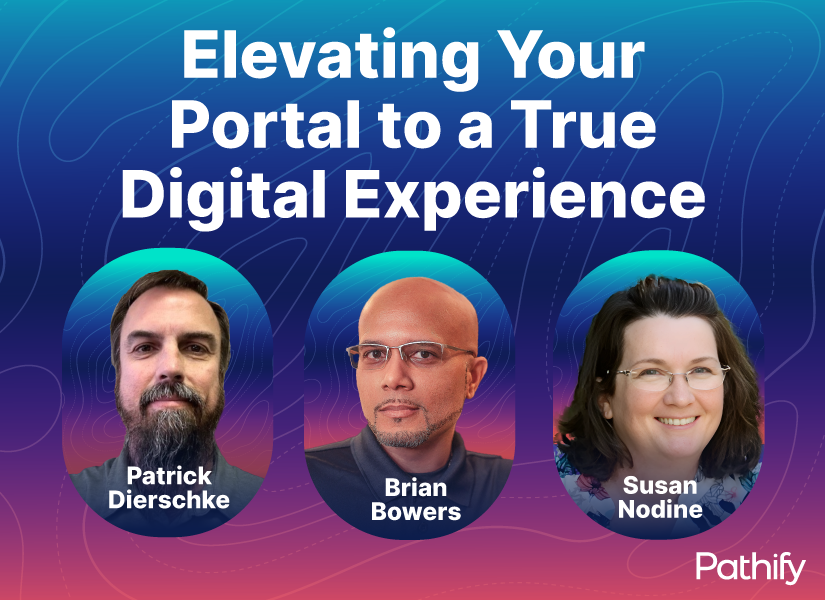Picture a bustling campus filled with students navigating a world of information and opportunities — from academics to student clubs and organizations, athletics, dining hall meals, student support services and more. Now, imagine this world’s digital complement — the student portal. What do you see? Is it a clunky, outdated webpage that feels more like a relic from the early days of the internet when dial-up reigned supreme? A mobile app with a completely different interface than the web-based companion? A list of links on your homepage providing the same user experience as a Word document with hyperlinks? Something more?
In today’s fast-paced, tech-savvy world, students expect more than just access to information — they demand intuitive, engaging digital experiences mirroring and enhancing their interactions across campus. In our recent webinar, we sat down with three Pathify customers — Patrick Dierschke from Angelo State University, Susan Nodine from Columbia College and Xavier University of Louisiana’s Brian Bowers — about the journey of replacing their student portals and how, after choosing Pathify, they turned their student experience upside down (in a good way … read on!).
Pre-Pathify Portal Experiences
All three panelists agreed in the olden days, their “pre-Pathify” portal experiences weren’t exactly progressive or intuitive. “Our old portal was stood up on SharePoint and didn’t serve students well, it was outdated and monochromatic,” recalled Susan Nodine, Columbia College’s Project Manager. Xavier University of Louisiana (XULA) experienced similar challenges with SharePoint. “Our old portal was completely static,” Brian Bowers explained. As XULA’s Manager of Web Development and Mobile Applications, the lack of two-way conversation and a mobile component concerned him. “The old portal simply displayed information. We had no real mobile component or interactiveness between students, faculty and staff,” he said.
Ellucian Luminis’ end-of-life announcement prompted Patrick Dierschke, Angelo State’s Learning and Communication Services Coordinator, to find a portal replacement ahead of Luminis’ sunset in June 2024. “We used Luminis for nearly twenty years, mainly as a link farm,” he commented. “As we evaluated replacements, we found we were behind the curve in what we provided students. Just as we’ve had to adjust our on-campus technologies, we needed to upgrade our online presence.”
On Serving the Modern Student
When evaluation for a new portal began, all three panelists credited the modern-day student, defined not by their age group or demographic, but by their habits, preferences and dispositions. “We needed to meet students where they are — online and on their mobile devices,” stated Bowers. Added Nodine, “Columbia College serves both traditional and non-traditional students. Oftentimes they may want or need different things but we knew they both wanted to find information quickly.” When Angelo State began evaluating portal vendors, Dierschke quickly pointed out the importance of stakeholder engagement. “We tried as much as possible to say ‘This isn’t just an IT project, but a community project,’” he said, emphasizing the importance of cross-campus collaboration and communication.
Although all three panelist institutions evaluated multiple portal solutions (including campus dashboard software Ellucian Experience), Pathify’s modern UI/UX, full web-mobile parity, customization capabilities, partnership and holistic campus experience sealed the deal, completely reshaping what they thought was possible. Nodine acknowledged scalability as another selling point, “What made Pathify a better product for us is many of the build items didn’t require our programmers’ involvement. It freed up their resources and didn’t create such a drain on them.”
Our portal now connects all our systems in one place, allowing student, faculty and staff to access those systems anytime they want.
Brian bowers, manager of web development & mobile applications, Xavier university of louisiana
Incremental Implementation
Successful portal transitions are possible with careful planning and collaboration across both institution and Pathify teams. Bowers shared, “Our plan to implement Pathify was very laid out, very detailed. We had a specific order so we could reach success.” For Nodine, implementation was methodically laid out to maximize resources. “We prioritized replacing the core portal before adding other features,” she said. Now, a year post-launch, Columbia College’s old portal is a distant memory. “We don’t even think about the old portal anymore,” she laughed. At Angelo State, Dierschke and his team are currently championing the implementation process, with a go-live date scheduled in Summer 2024. “No stone has been left unturned when it comes to implementation,” he reflected. “I don’t think we’d be positioned to go live without such a cohesive partnership.”
Enhancements & Engagement
Looking ahead, Nodine, Dierschke and Bowers remain focused on maximizing the potential of their portals through integrations and ongoing enhancements. “There are quite a few widgets we’d like to explore,” Nodine stated. “Now that we’re a year in, we know the ease of setting up integrations.” At XULA, Bowers’ team concentrates on similar upgrades. “One of our biggest goals involves increasing engagement,” he said. In doing so, XULA plans to continue consolidating redundant systems by integrating athletics information into their Calendars & Events widgets. Above all, providing a centralized hub for all campus constituents proves invaluable. “Our portal now connects all our systems in one place, allowing students, faculty and staff to access those systems anytime they want,” Bowers concluded.
The transformative journey from outdated student portals to modern, consolidated, user-centric platforms is driven by the shared goal of enhancing the student experience. As institutions like Angelo State University, Columbia College and Xavier University of Louisiana boldly embrace change and prioritize innovation, they’re not just meeting today’s students’ needs — they’re trailblazing a new era of campus experiences.
